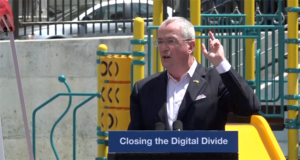The co-founder and school leader of Hope Academy Charter School in Asbury Park, Alexis Harris, has an editorial in the Asbury Park Press in which she chides the State for not making good on payments due. Charter schools are supposed to receive 90% of the funding per child in a traditional public school, but Harris claims that Hope Academy is getting less than 50%.
What’s this mean in real numbers? The State pays $26,000 per kids in Asbury Park district schools – remember, that’s an Abbott district – but this year has cut Hope Academy’s budget to less than $12,000 a kid, according to Harris. She writes,
We are not asking for an outlandish sum. In fact, we are showing how much more can be attained with less funding. But less funding should not mean inadequate funding nor should it value a charter school child’s education at less than half the value placed on the education of a district school child. Both are children in public schools in the same community but they are being treated unequally because of some discriminatory decisions.
Let’s look at some of the real numbers, at least the most up-to-date numbers on the D.O.E. website
for 2007-2008. Hope Academy, tiny with only about one class per grade (though it has a waiting list of 141 kids – more than the current enrollment) averages about 13-15 kids per class. Only 4.5% of their kids are classified as needing special education services. Their test scores are mixed: on the NJ ASK 3, the State test given to all 3d graders in math and language arts, 73.3% passed language and 53.3% passed math. (Yes, 46.7% of their 3d graders failed – er, were “partially proficient” in – math.) On the NJ ASK 5, 13% of the 5th graders passed language arts and 33.3% passed math. The total cost per pupil on the DOE website is listed at $16,994.
Asbury Park doesn’t have a K-8 school, so we looked at an elementary school, Bradley Elementary, which serves kids in grades K-3, and an intermediate school, Asbury Park Intermediate, which runs 4-8. Bradley has an average class size of between 18 and 22 kids; A.P.I. has an average class size of 15-25. At Bradley, 11% of kids have Individualized Education Plans, which means that they are classified as needing special education; at A.P.I. 19.2% have I.E.P.’s. 65.4% of Bradley’s 3d grade students passed language arts and 48.1% passed math. That’s slightly worse than 3d graders at Hope Academy. For fifth graders at A.P.I., 15.4% passed language arts and 34.7% passed math. That’s a tiny bit better than the kids at Hope. The total cost per pupil for both Bradley and A.P.I. is listed at $20,104.
It’s not clear what the real discrepancy in spending is. The D.O.E.’s numbers for 2007-2008 make it a measly $4K per child, but Harris says it’s more like $14K. The D.O.E.’s numbers don’t completely reflect the extra services allotted for Abbott students, and it’s certainly likely that the State and local district didn’t make good on the full amount due to the charter school. Neither set of test scores is anything to write home about and the district schools have more kids with special needs.
Here’s what is not ambiguous: Hope Academy is managing to educate children about as well (or about as poorly) as the traditional public schools in Asbury Park. They are spending less money per child to do so. More parents would like their children to be educated at the charter. Shouldn’t the State D.O.E. be encouraging alternative ways of providing education to our kids, especially those in poor urban districts with a history of failing schools?


